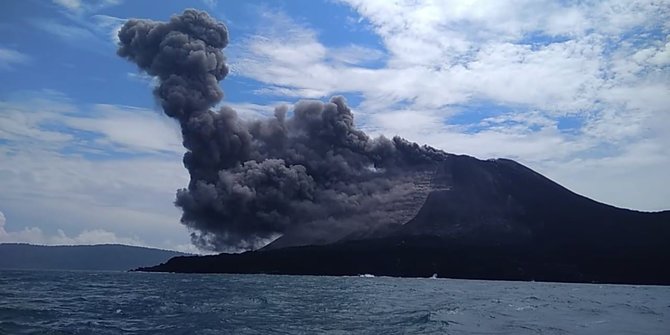 Anak Krakatau erupted on Tuesday, spewing 1,000m ash and smoke column. (Image via Merdeka.com)
Anak Krakatau erupted on Tuesday, spewing 1,000m ash and smoke column. (Image via Merdeka.com)
Ahead of New Year's Day, Anak Krakatau erupts
On Tuesday, the Volcanology and Geological Disaster Mitigation Center (PVMBG) reported that Anak Krakatau (Child of Krakatau), Lampung, erupted at around 06.51 a.m. local time. A black column of ash and smoke as the product of the eruption rose around 1,000m in height of around 1,157m above the sea levels, tilting to south direction.The Head of PVMBG, Kasbani, told that the eruption was recorded on the seismograph with the maximum amplitude of 44mm and lasted about a minute and 33 seconds. But, no explosive sound was heard.
Due to the eruption, PVMBG advised both the locals and tourists to stay away from the crater’s vicinity under a two-kilometer radius.
Fortunately, Kasbani said that the eruption would not affect any flights.
Since 25 March 2019, the alert level status for Anak Krakatau is still classified as “Level II” or “Caution”. Kompas tabulated that The 157-m-above-the-sea-level volcano had been seeing a surge of volcanic activities since June last year, with strings of explosions followed from September 2018 to February 2019.
The most recent eruption happened on early Sunday when Anak Krakatau erupted at 5.29 a.m., spewing 200-high ash and smoke column. The eruption lasted for two minutes.
Anak Krakatau is one of the 17 Indonesian volcanoes classified within Level II. Other than that, there are three more active volcanoes classified within Level III or “Watch”. They are Karangetan Volcano & Mount Sinabung, both in Sulawesi Utara; and, Mount Agung, Bali.
The predecessor of Anak Krakatau, Krakatau, produced one of the biggest and worst eruptions in the world's history, killing more than 36,000 people with a tsunami due to its gigantic wave and lowering the Earth’s surface temperature by 1°C. with its ash. Anak Krakatau emerged from the area in 1927 and has been growing ever since.
Source: https://bit.ly/2MHV2qS
 English
English Japan
Japan

viagra professional vs regular viagra men's clinic for erectile dysfunction what does viagra do how much does viagra cost adverse effects of sildenafil cost of generic viagra at cvs
online games sex adult sex games mobile farm sex games
viagra for blood pressure patients viagra meaning free medication samples for physicians male enhancement pills walmart women increased libido over 40 viagra en ligne street value of viagra rx west discount card when cialis doesn't work instant natural viagra best generic viagra websites best libido herbal supplements for men belviq weight loss buying viagra dr oz erectile dysfunction treatment organic male enhancement pills best herb for women's libido viagra otc taking expired pills drug interactions with flomax compra viagra what is red pill theory cialis 30 tablet trial cialis 30 mg dose viagra on line singer pink autograph ebay how long does viagra take to work walgreens appetite suppressant pills best natural substitute for viagra viagra cock where is extenze sold
check ordering walmart cheapest generic ed meds viagra online kaufen join facebook class action lawsuit natural sexual supplements for men samples from pfizer viagra coupons
new ed pill better than viagra male penile enhancement exercises can you take viagra daily order viagra pills online cost of viagra at walmart top male enhancement pills walgreens
cvs quarterly extra bucks dates is cialis covered by medicaid cheap viagra prescription can women take men's viagra tadalafil generic best prices